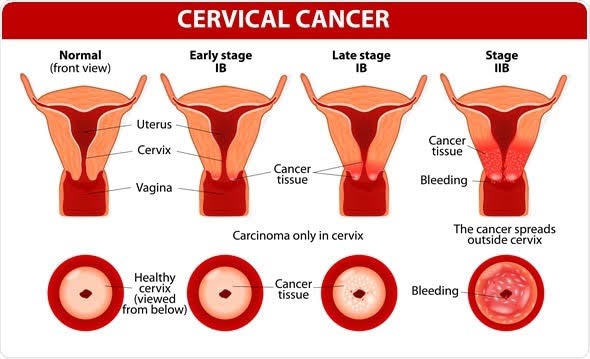From cradle, every human is biologically expected to traverse series of developmental process. The inescapable growth of every being and the impinging environmental activities determine to a large extent the health status of every person. Diseases abound in every human society and they come in various forms and shades- Malaria, Hypertension, Yellow fever, Diabetes, Cancer and many more.
 Definition
Definition
Cancer, and in this case, cervical cancer as a chronic disease has been a subject of intense intellectual discourses for quite a long time. By definition, cervical cancer is the tumor of the cervix. Cervix is the neck of the womb while, tumor is abnormal growth of the cells in the body that spread to invade the surrounding tissue.
Types
There are various types of cervical cancer: Squamous cell carcinoma, which develops from the squamous cell which covers the cervix. It is the most common and account for 80% of all cervical carcinoma. Others are: adenocarcinoma, which develops from a glandular cell within the cervical canal, Carcinoma in situ and metastatic carcinoma. It should be noted that cancer cervix is most common in women of 45 to 55 years and about half a million people are affected by the disease worldwide. Regrettably, the disease is most common in women in developing countries where there is prevalence of low socio economic indices.
Risk Factors
The risk factors for cervical cancer include: lack of screening, multiple child birth, multiple sexual partner or having partner that have multiple sexual partners; multiple pregnancy, early sexual intercourse, low immunity-women on steroids, HIV patient, diabetic patient, infection with sexually transmitted infections such as human papilloma virus.
Symptoms
The symptoms of cervical cancer include: vagina discharge – foul smelling, occasional bleeding in between period, post coital bleeding (bleeding after sex) and post-menopausal vaginal bleeding. It should be noted that cervical cancer does not present any symptoms in the early stage.
Screening Methods
Cervical cancer can be screened through these methods: Pap smear, Visual inspection with acetic acid (ViA), Visual inspection with lugol iodine (VILI) and HPV screening. Visual inspection with acetic acid (VIA) is a cost effective screening method and the test is done every three years. The process is not painful and takes only fifteen minutes. The woman lies in lithotomy position while a sterile speculum is passed into her vagina thereby exposing the cervix and the cervix is inspected and 3-5% acetic acid is applied to it. Thereafter, the cervix is then inspected for any changes, the findings are noted and recorded and the speculum removed. If the outcome is positive, the woman is informed and treated thereby preventing the cervical cancer precursor cell from becoming cancerous and the woman is hence saved from the deadly disease.
Preventive Mechanism
The preventive mechanism come in through diet-take diet that is rich in vegetable and fruits. Taking three to five serving of vegetables protects a woman from any form of cancer, regular exercise; walking, jumping, running, jogging and many more; Immunization against HPV and screening which reduces morbidity and mortality from the disease.
By: Dr. (Mrs.) O.R. Ogunbowale (Ag. Director, University Health Services, OOU)

